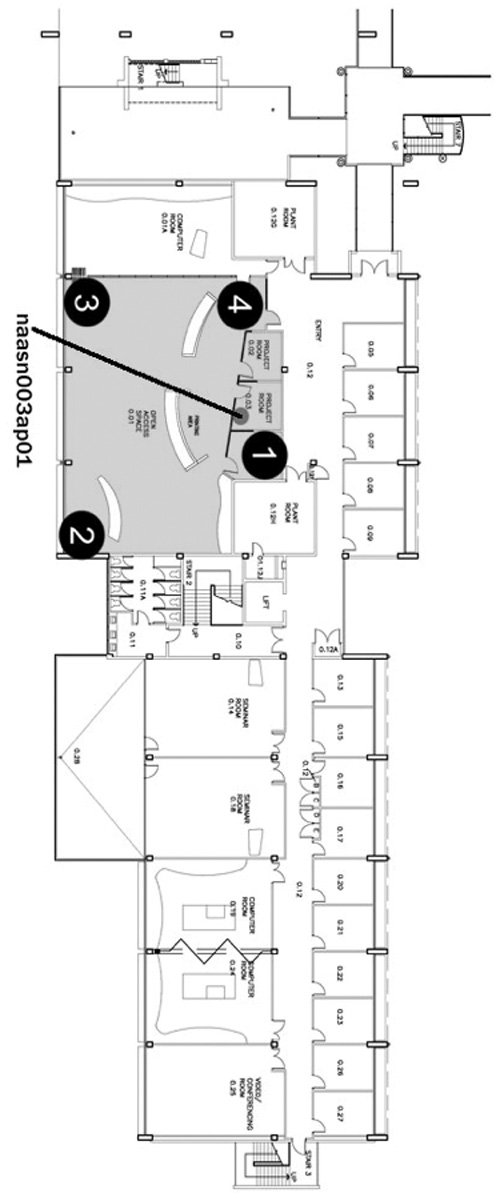Deployment and Implementation
| Deployment of Griffith University's WLAN solution was undertaken on a phased basis. This approach allowed the university's IT staff to validate the architecture from a technical and security basis, introduce the services on an incremental basis, ensure that support staff were among the first to familiarize themselves with and benefit from the solution, and finally avoid the "big bang" approach for service introduction. Careful site surveys were undertaken and cabling was laid before each access point was installed. Finally, each Smart Zone was tested before being launched as a production service. Deployment PhasesPhase One of the deployment concentrated on IT areas, cafes, outdoor locations, libraries, and learning centers. The areas selected for Phase One were partly defined by the end users (see "Lessons Learned and Recommendations" later) through proactive user surveys and requirements definitions. Note Learning centers are "computer labs on steroids," according to Scott. They are specialized areas set aside for student study, research, and educational activity. Griffith University learning centers typically house 90 desktop PCs in a large open area, with additional breakout rooms and group study rooms available to students. Highly used and very popular, the learning centers provide the students with a dedicated space within the university environment to concentrate on their academic activities. They were a logical prime location for early deployment. Phase Two of the deployment added all seminar rooms and 80 percent of "bookable" teaching areas (excluding the main lecture halls and laboratories). All staff meeting rooms and common rooms were also included. This phase was only undertaken after the successful completion of Phase One; in other words, the Network and Communications Services team addressed any problems that were identified during Phase One before proceeding with more widespread deployment. Phase Two saw the extension of WLAN coverage into teaching areas and greatly increased the "footprint" of the solution, with more than 150 additional access points deployed. Phase Three of Griffith University's deployment addressed the lecture halls and scientific laboratories. Only recently completed (late 2005), this phase adds to the coverage and extends the service into practically all teaching areas. Nearly all outside areas where staff and students congregate are now covered. A planned fourth phase will be undertaken in. This phase will address dead spots identified by end users and the Network and Communications Services team, in addition to remaining areas that were originally deemed low priority. Phase Four will bring the university closer to ubiquitous coverage. Site Survey
An independent vendor was appointed to undertake the site surveys and the installation and configuration of the access points. The vendor was given detailed instructions and a template from which to work. These instructions included the stipulation that a signal strength of at least 50 percent (when measured by the Cisco Airnet Client Utility) was required at all locations within the Smart Zone. This requirement was achieved by taking four signal strength measurements at the extreme edges of the Smart Zone. Where coverage problems occurred, external high-gain antennas were used. Figure 12-3 shows the location of access point naasn003ap01 in a project room. The four black circles mark the locations where Griffith IT staff measured signal strength to ensure that it met the 50 percent benchmark. Figure 12-3. Validating Signal StrengthReprinted with permission of Griffith University Some general guidelines have been adopted over the course of the deployment phases. These guidelines, based upon environmental factors and the nature of university buildings, offer further direction during the site survey process:
For soundproof rooms and laboratories, access points are mounted inside an AV cabinet or in an area where the signal will pass through a glass window into such a room. CablingDuring Phase Three, it was decided that two cables per access point would be installed. Originally, this provision was to allow for an extra access point to be installed in the future, should demand increase. However, university IT staff discovered that they could use the second cable for console access, providing out of band (OOB) management capabilities. This capability has proven to be of great assistance to the IT staff, not the least because of the extended nature of the university's wireless network, which is spread over five campus locations. Two cables per access point now forms part of the Office of Facilities Management (OFM) building standard. Access Point ConfigurationThe site survey vendor configured the access points, working from a template and detailed work instructions, which expedited the deployment and avoided university staff resourcing problems. TestingUpon physical installation of the access points by the site survey vendor, the access points were configured and tested. During each deployment phase and before the service was launched in each area, the WLAN was tested again by IT staff, and coverage maps were generated. Only after service availability was validated were the areas added to the web portal and the WLAN made available to users in that locality. |
EAN: 2147483647
Pages: 163
